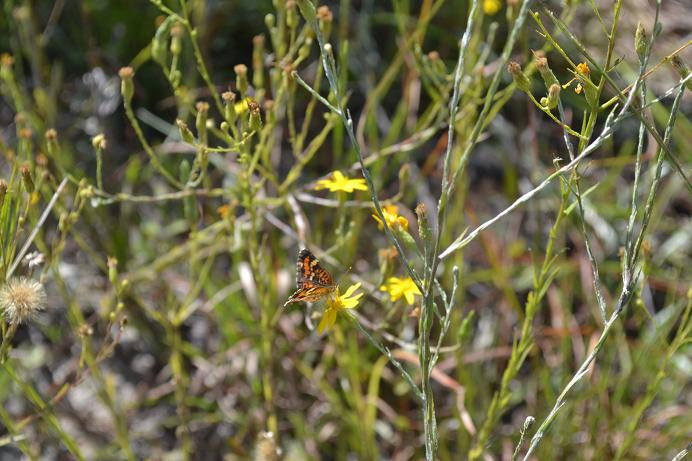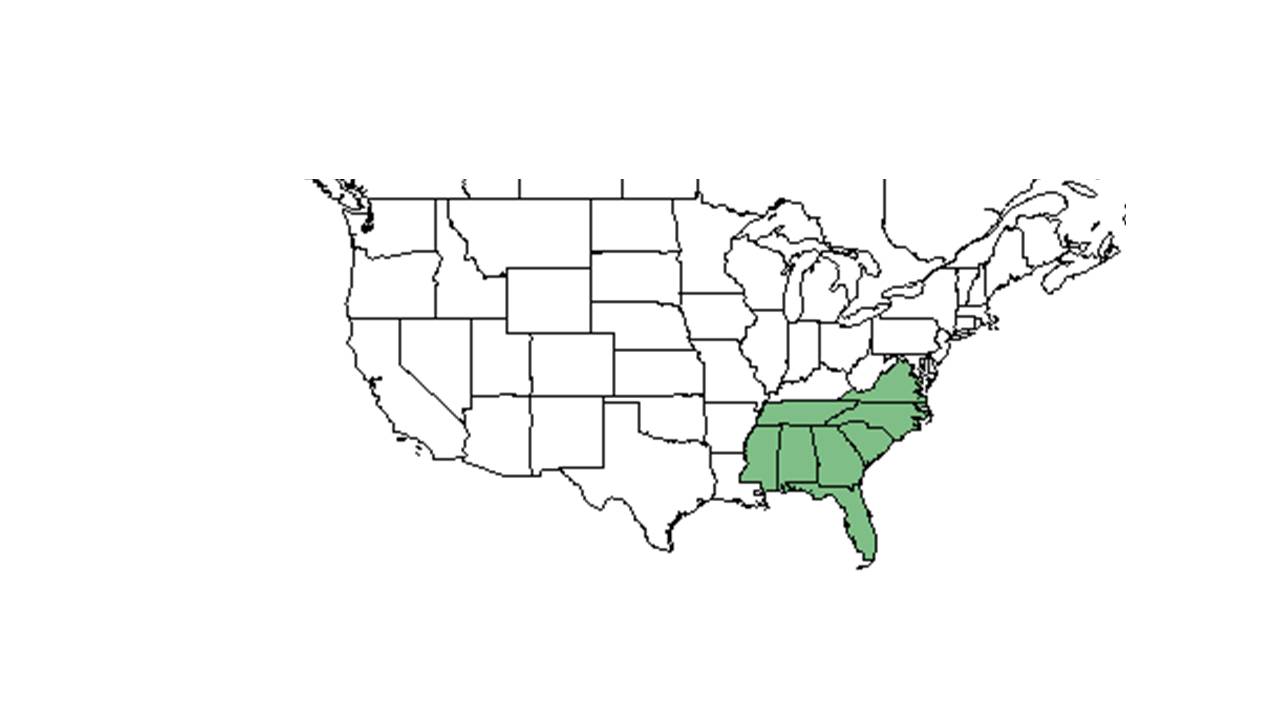Difference between revisions of "Pityopsis aspera"
(→Photo Gallery) |
|||
| (25 intermediate revisions by 11 users not shown) | |||
| Line 20: | Line 20: | ||
Common name: pineland silkgrass | Common name: pineland silkgrass | ||
==Taxonomic notes== | ==Taxonomic notes== | ||
| + | Synonyms: ''Chrysopsis graminifolia'' (Michaux) Elliott, misapplied; ''Heterotheca adenolepsis'' (Fernald) H.E. Ahles; ''Pityopsis adenolepsis'' (Fernald) Semple; ''Heterotheca aspera'' (Shuttleworth ex Small) Shinners<ref name=weakley>Weakley, A.S. 2020. Flora of the Southeastern United States. Edition of 20 October 2020. University of North Carolina at Chapel Hill, Chapel Hill, North Carolina.</ref> | ||
| + | |||
| + | Varieties: ''Pityopsis aspera'' (Shuttleworth ex Small) Small var. ''adenolepsis'' (Fernald) Semple & F.D. Bowers; ''P. aspera'' (Shuttleworth ex Small) Small var. ''aspera''; ''Heterotheca adenolepsis'' (Fernald) H.E. Ahles; ''Heterotheca graminifolia'' (Michaux) Shinners, misapplied<ref name=weakley/> | ||
| + | |||
==Description== | ==Description== | ||
<!-- Basic life history facts such as annual/perrenial, monoecious/dioecious, root morphology, seed type, etc. --> | <!-- Basic life history facts such as annual/perrenial, monoecious/dioecious, root morphology, seed type, etc. --> | ||
| − | + | The basal leaves are longer than the stem leaves, which strongly reduce upward. The lower leaves are silky-pubescent while the mid to upper stem leaves are glabrate and noticeably stipitate-glandular along the margins. The stems are glandular to the base. There are fewer than 10 flower heads and the involucres are 4.5-8 mm high.<ref name=weakley/> | |
==Distribution== | ==Distribution== | ||
| + | This plant ranges from the eastern Florida Panhandle to adjacent central Georgia.<ref name=weakley/> | ||
| + | |||
==Ecology== | ==Ecology== | ||
===Habitat=== <!--Natural communities, human disturbed habitats, topography, hydrology, soils, light, fire regime requirements for removal of competition, etc.--> | ===Habitat=== <!--Natural communities, human disturbed habitats, topography, hydrology, soils, light, fire regime requirements for removal of competition, etc.--> | ||
| − | ''P. aspera'' is distributed across southern Georgia and northern Florida | + | ''P. aspera'' is distributed across southern Georgia and northern Florida<ref name="Gowe and Brewer 2005">Gowe, A. K. and J. S. Brewer (2005). "The evolution of fire-dependent flowering in goldenasters (Pityopsis spp.)." Journal of the Torrey Botanical Society 132: 384-400.</ref> and is commonly found in Florida sandhill community.<ref name="Downer 2012"/> Habitats documented include longleaf wiregrass sandhills, deep sand banks along hardwood hammocks, open pinewoods, longleaf pine/turkey oaks, scrub oak barrens, longleaf pine savannas, sand pine-evergreen oak scrubs, a high bluff, and chestnut oak woods.<ref name="FSU Herbarium">Florida State University Robert K. Godfrey Herbarium database. URL: [http://herbarium.bio.fsu.edu http://herbarium.bio.fsu.edu]. Last accessed: July 2015. Collectors: John B. Nelson, R.K. Godfrey, John Morrill, Loran C. Anderson, Douglas E. Kennemore, Jr., R. Komarek, Kevin Oakes, M. Davis, Bruce Hansen, JoAnn Hansen, Lloyd H. Shinners, Kurt E. Blum, Sidney McDaniel, R. Kral, Richard D. Houk, H. E. Grelen, A. F. Clewell, Paul L. Redfearn, Jr., Gary R. Knight, Jean Wooten, Richard S. Mitchell, A. Dobay, Krista Heine, Batson, Wilbur H. Duncan, Krista Heine, A. Dobay, John H. Beaman, William B. Fox, A.B. Seymour, Angus Gholson, C. Ritchie Bell, W.J. Dress, R.V. Moran, Samuel B. Jones, Jr., Cindi Stewart, MacClendons. States and Counties: Florida: Baker, Bay, Calhoun, Escambia, Franklin, Gadsden, Grady, Gulf, Holmes, Jackson, Jefferson, Leon, Liberty, Madison, Okaloosa, Santa Rosa, Union, Wakulla, Walton, Washington. Georgia: Baker, Bartow, Bulloch, Clayton, Decatur, Grady, Houston, Macon, Taylor, Thomas, Upson. South Carolina: Aiken, Chester, York. North Carolina: Alegheny, Alexander, Burke, Gatson, Johnston, McDowell, Moore, Richmond, Rutherford, Surry, Wake. Virginia: Brunswick. Mississippi: Forrest, Harrison, Lamar. Alabama: Baldwin, Barbour, Covington, Geneva, Lee, Mobile. Compiled by Tall Timbers Research Station and Land Conservancy.</ref> In disturbed areas it grows in beds of old railroads, roadsides with bahia grass, a clearing of mixed pine-hardwood stand, harrowed areas, bordering fields, and on golf course edges alongside broomsage.<ref name="FSU Herbarium"/> Additionally, ''P. aspera'' is an indicator species for the Panhandle Xeric Sandhills community type as described in Carr et al. (2010).<ref>Carr, S.C., K.M. Robertson, and R.K. Peet. 2010. A vegetation classification of fire-dependent pinelands of Florida. Castanea 75:153-189.</ref> Associated soil types include sand, dry loamy sand, dry clayey sand, gray sand, wet soil, dry sand-clay bank, loam soil, red clay bank, and gravelly-clay.<ref name="FSU Herbarium"/> |
| − | Associated species include ''Pityopsis flexuosa, Pinus palustris, Aristida stricta, Chrysopsis latisquamea, Chrysopsis gossypina Quercus, Paronychia'', bahia grass, ''Haplopappus divaricatus, Eupatorium pinnatifidum, Lechea, Diodia teres, Dicanthelium, Lespedeza hirta, Polygonella gracilis, Vaccinium arboreum'', sandpine, ''Microcephala, Liatris, Panicum, Leptoloma cognata, Phoebanthus, Scleria ciliata, Helianthus microcephalus, Helianthus atrorubens, Silphium compositum, Eupatorium, Heterotheca latifolia'' and chestnut oak | + | Associated species include ''Pityopsis flexuosa, Pinus palustris, Aristida stricta, Chrysopsis latisquamea, Chrysopsis gossypina Quercus, Paronychia'', bahia grass, ''Haplopappus divaricatus, Eupatorium pinnatifidum, Lechea, Diodia teres, Dicanthelium, Lespedeza hirta, Polygonella gracilis, Vaccinium arboreum'', sandpine, ''Microcephala, Liatris, Panicum, Leptoloma cognata, Phoebanthus, Scleria ciliata, Helianthus microcephalus, Helianthus atrorubens, Silphium compositum, Eupatorium, Heterotheca latifolia'' and chestnut oak.<ref name="FSU Herbarium"/> |
===Phenology=== <!--Timing off flowering, fruiting, seed dispersal, and environmental triggers. Cite PanFlora website if appropriate: http://www.gilnelson.com/PanFlora/ --> | ===Phenology=== <!--Timing off flowering, fruiting, seed dispersal, and environmental triggers. Cite PanFlora website if appropriate: http://www.gilnelson.com/PanFlora/ --> | ||
| − | + | ''P. aspera'' flowers from August through October.<ref name=weakley/> | |
| + | <!--===Seed bank and germination===--> | ||
| − | |||
| − | |||
===Fire ecology=== <!--Fire tolerance, fire dependence, adaptive fire responses--> | ===Fire ecology=== <!--Fire tolerance, fire dependence, adaptive fire responses--> | ||
| − | ''P. aspera'' occurs in areas with an estimated pre-settlement fire-return interval of 1-3 years | + | ''P. aspera'' occurs in areas with an estimated pre-settlement fire-return interval of 1-3 years<ref name="Gowe and Brewer 2005"/> and flowers within two months of burning in early summer.<ref name="Robertson">Robertson, Kevin M. 2014. Personal observation.</ref> Populations have been known to persist through repeated annual burns.<ref>Robertson, K.M. Unpublished data collected from Pebble Hill Fire Plots, Pebble Hill Plantation, Thomasville, Georgia.</ref><ref>Platt, W.J., R. Carter, G. Nelson, W. Baker, S. Hermann, J. Kane, L. Anderson, M. Smith, K. Robertson. 2021. Unpublished species list of Wade Tract old-growth longleaf pine savanna, Thomasville, Georgia.</ref> |
| + | <!--===Pollination===--> | ||
| + | <!--===Herbivory and toxicology===--> <!--Common herbivores, granivory, insect hosting, poisonous chemicals, allelopathy, etc--> | ||
| + | <!--===Diseases and parasites===--> | ||
| − | == | + | ==Conservation, cultivation, and restoration== |
| − | |||
| − | |||
| − | == | + | ==Cultural use== |
| − | |||
==Photo Gallery== | ==Photo Gallery== | ||
<gallery widths=180px> | <gallery widths=180px> | ||
| Line 50: | Line 55: | ||
==References and notes== | ==References and notes== | ||
| − | |||
| − | |||
| − | |||
| − | |||
| − | |||
| − | |||
| − | |||
Latest revision as of 14:51, 20 June 2023
| Pityopsis aspera | |
|---|---|

| |
| Photo taken by Kevin Robertson | |
| Scientific classification | |
| Kingdom: | Plantae |
| Division: | Magnoliophyta - Flowering plants |
| Class: | Magnoliopsida – Dicotyledons |
| Order: | Asterales |
| Family: | Asteraceae ⁄ Compositae |
| Genus: | Pityopsis |
| Species: | P. aspera |
| Binomial name | |
| Physalis arenicola (Shuttlw. ex Small) Small | |

| |
| Natural range of Physalis arenicola from USDA NRCS Plants Database. | |
Common name: pineland silkgrass
Contents
Taxonomic notes
Synonyms: Chrysopsis graminifolia (Michaux) Elliott, misapplied; Heterotheca adenolepsis (Fernald) H.E. Ahles; Pityopsis adenolepsis (Fernald) Semple; Heterotheca aspera (Shuttleworth ex Small) Shinners[1]
Varieties: Pityopsis aspera (Shuttleworth ex Small) Small var. adenolepsis (Fernald) Semple & F.D. Bowers; P. aspera (Shuttleworth ex Small) Small var. aspera; Heterotheca adenolepsis (Fernald) H.E. Ahles; Heterotheca graminifolia (Michaux) Shinners, misapplied[1]
Description
The basal leaves are longer than the stem leaves, which strongly reduce upward. The lower leaves are silky-pubescent while the mid to upper stem leaves are glabrate and noticeably stipitate-glandular along the margins. The stems are glandular to the base. There are fewer than 10 flower heads and the involucres are 4.5-8 mm high.[1]
Distribution
This plant ranges from the eastern Florida Panhandle to adjacent central Georgia.[1]
Ecology
Habitat
P. aspera is distributed across southern Georgia and northern Florida[2] and is commonly found in Florida sandhill community.[3] Habitats documented include longleaf wiregrass sandhills, deep sand banks along hardwood hammocks, open pinewoods, longleaf pine/turkey oaks, scrub oak barrens, longleaf pine savannas, sand pine-evergreen oak scrubs, a high bluff, and chestnut oak woods.[4] In disturbed areas it grows in beds of old railroads, roadsides with bahia grass, a clearing of mixed pine-hardwood stand, harrowed areas, bordering fields, and on golf course edges alongside broomsage.[4] Additionally, P. aspera is an indicator species for the Panhandle Xeric Sandhills community type as described in Carr et al. (2010).[5] Associated soil types include sand, dry loamy sand, dry clayey sand, gray sand, wet soil, dry sand-clay bank, loam soil, red clay bank, and gravelly-clay.[4]
Associated species include Pityopsis flexuosa, Pinus palustris, Aristida stricta, Chrysopsis latisquamea, Chrysopsis gossypina Quercus, Paronychia, bahia grass, Haplopappus divaricatus, Eupatorium pinnatifidum, Lechea, Diodia teres, Dicanthelium, Lespedeza hirta, Polygonella gracilis, Vaccinium arboreum, sandpine, Microcephala, Liatris, Panicum, Leptoloma cognata, Phoebanthus, Scleria ciliata, Helianthus microcephalus, Helianthus atrorubens, Silphium compositum, Eupatorium, Heterotheca latifolia and chestnut oak.[4]
Phenology
P. aspera flowers from August through October.[1]
Fire ecology
P. aspera occurs in areas with an estimated pre-settlement fire-return interval of 1-3 years[2] and flowers within two months of burning in early summer.[6] Populations have been known to persist through repeated annual burns.[7][8]
Conservation, cultivation, and restoration
Cultural use
Photo Gallery
References and notes
- ↑ 1.0 1.1 1.2 1.3 1.4 Weakley, A.S. 2020. Flora of the Southeastern United States. Edition of 20 October 2020. University of North Carolina at Chapel Hill, Chapel Hill, North Carolina.
- ↑ 2.0 2.1 Gowe, A. K. and J. S. Brewer (2005). "The evolution of fire-dependent flowering in goldenasters (Pityopsis spp.)." Journal of the Torrey Botanical Society 132: 384-400.
- ↑ Cite error: Invalid
<ref>tag; no text was provided for refs namedDowner 2012 - ↑ 4.0 4.1 4.2 4.3 Florida State University Robert K. Godfrey Herbarium database. URL: http://herbarium.bio.fsu.edu. Last accessed: July 2015. Collectors: John B. Nelson, R.K. Godfrey, John Morrill, Loran C. Anderson, Douglas E. Kennemore, Jr., R. Komarek, Kevin Oakes, M. Davis, Bruce Hansen, JoAnn Hansen, Lloyd H. Shinners, Kurt E. Blum, Sidney McDaniel, R. Kral, Richard D. Houk, H. E. Grelen, A. F. Clewell, Paul L. Redfearn, Jr., Gary R. Knight, Jean Wooten, Richard S. Mitchell, A. Dobay, Krista Heine, Batson, Wilbur H. Duncan, Krista Heine, A. Dobay, John H. Beaman, William B. Fox, A.B. Seymour, Angus Gholson, C. Ritchie Bell, W.J. Dress, R.V. Moran, Samuel B. Jones, Jr., Cindi Stewart, MacClendons. States and Counties: Florida: Baker, Bay, Calhoun, Escambia, Franklin, Gadsden, Grady, Gulf, Holmes, Jackson, Jefferson, Leon, Liberty, Madison, Okaloosa, Santa Rosa, Union, Wakulla, Walton, Washington. Georgia: Baker, Bartow, Bulloch, Clayton, Decatur, Grady, Houston, Macon, Taylor, Thomas, Upson. South Carolina: Aiken, Chester, York. North Carolina: Alegheny, Alexander, Burke, Gatson, Johnston, McDowell, Moore, Richmond, Rutherford, Surry, Wake. Virginia: Brunswick. Mississippi: Forrest, Harrison, Lamar. Alabama: Baldwin, Barbour, Covington, Geneva, Lee, Mobile. Compiled by Tall Timbers Research Station and Land Conservancy.
- ↑ Carr, S.C., K.M. Robertson, and R.K. Peet. 2010. A vegetation classification of fire-dependent pinelands of Florida. Castanea 75:153-189.
- ↑ Robertson, Kevin M. 2014. Personal observation.
- ↑ Robertson, K.M. Unpublished data collected from Pebble Hill Fire Plots, Pebble Hill Plantation, Thomasville, Georgia.
- ↑ Platt, W.J., R. Carter, G. Nelson, W. Baker, S. Hermann, J. Kane, L. Anderson, M. Smith, K. Robertson. 2021. Unpublished species list of Wade Tract old-growth longleaf pine savanna, Thomasville, Georgia.